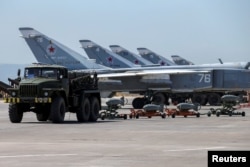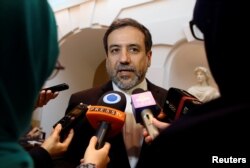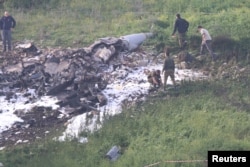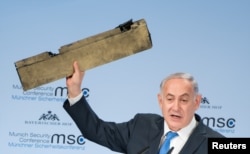Moscow may have deployed two of its latest-generation stealth warplanes to Syria, according to video footage of a pair of Su-57s landing at a Russian airbase in the war-torn country.
The reported deployment, seen on social media, comes amid rising alarm that the Syria conflict that started out as an uprising against President Bashar al-Assad and is now split into several separate struggles could erupt into a wider regional clash between outside powers.
The video allegedly shows a pair of Su-57s — Moscow's most advanced combat warplanes — landing this week at Russia's Hmeimim air base southeast of the city of Latakia on Syria's Mediterranean coastline. It quickly circulated Thursday on social media sites.
Downplays threat
The U.S. Defense Department on Thursday declined to confirm the deployment of Russia's newest stealth jets to Syria, but voiced concern despite downplaying the threat.
"The addition of fifth-generation fighters into Syria would certainly not be in keeping with Russia's announced force drawdown," Pentagon spokesman Eric Pahon said in a statement.
"We do not consider these jets to be a threat to our operations in Syria, and will continue to deconflict operations as necessary," Pahon said.
"We call on all parties, however, to remain focused on defeating ISIS, de-escalating and resolving the Syrian conflict, and protecting innocent civilians," he added, using an acronym for the militant group.
U.S. officials have repeatedly accused Russia of using Syria "literally as a showroom" for its military and defense industries.
"They have absolutely made an effort to show off a bunch of military capabilities," a U.S. official previously told VOA, regarding Moscow's use of airpower and missile technology.
If Russia has deployed Su-57s, it would mark a significant addition to Moscow's firepower in a theater of war that now features a dizzying array of competing forces and increased military involvement by outside sponsors, including Russia and Iran on Assad's side; Turkey, which is determined to stop Syrian Kurds from establishing an autonomous state of their own; and the U.S., which has aligned with the Kurds to defeat the Islamic State.
On Thursday, Iran Deputy Foreign Minister Abbas Araqchi warned of the risk of the multisided fighting in Syria spreading, with regional players being brought into direct conflict.
"Fear of war is everywhere in our region," Araqchi said.
Use of drones
In an interview with the BBC, he refused to confirm that Iran had flown a drone in Israeli airspace launched from Syria earlier this month. The overflight sparked a confrontation leading to the downing of an Israeli fighter jet and major retaliatory Israel airstrikes on Syria's air defense system and Iranian military bases in Syria.
Araqchi said the drone belonged to the Syrian army, and accused Israel of flying drones over Syria and other neighboring countries.
"They shouldn't be angry when they are faced with something that they are doing against others on a daily basis," he said.
Earlier this week, Israeli Prime Minister Benjamin Netanyahu, at an international security conference in Munich, dramatically brandished what he said was a piece of the Iranian drone Israel had shot down, saying Iran was the "greatest threat to our world."
Israel has been mounting increasing airstrikes in recent weeks in Syria, fearful that the radical Lebanese Shiite militia Hezbollah, sponsored by Iran, will consolidate bases in Syria from which to threaten Israel's northern border.
Every day in Syria's crowded airspace, warplanes from a half-dozen countries are flying in ever closer proximity, increasing the dangers of a clash, which could turn a war of proxies into an all-out confrontation between jostling outside powers, all of whom are determined to shape the outcome of the messy Syria conflict.
Footage posted Thursday by Syrian political activists purported to show four Su-35 fighter jets and four Su-25 strike aircraft escorting the Su-57s as they came in to land at the Hmeimim air base.
WATCH: Video purportedly showing Su-25 in the skies of Latakia
Operational
Russia has manufactured a dozen Su-57s. The single-seat, twin-engine jets are due to enter operational squadrons formally next year after years of problem-plagued development. Nicknamed the "F-22 killer," the Su-57 has been earmarked by the Russian military as a direct competitor to America's U.S. F-22 Raptor.
Russian and Syrian officials have not commented on the unverified video footage, but pro-Assad news sites welcomed the additional firepower.
Beirut-based Al-Masdar News, which boasts close links with the Syrian military, said: "With the arrival of the Su-57s (and additional warplanes in general), it appears that Moscow is expecting major escalations in Syria during 2018 and — having been caught off-guard in the past — wants to be fully prepared for any drastic situation that may arise."
In December, Russian leader Vladimir Putin declared Moscow's mission in Syria had been accomplished — a declaration coinciding with confirmation that he'd seek a fifth term as Russia's president in elections in March. He said Russia would start a military drawdown.
Defense Minister Sergei Shoigu announced on the same day as Putin's victory declaration was made that 38 warplanes had returned to Russia.
Airstrikes in Syria
But Moscow has remained trapped in Syria, say analysts. Its military power has been needed by Assad to support offensives against remaining rebel holdouts in the northwestern province of Idlib and in the Damascus suburb of eastern Ghouta, which has seen in the past four days some of the most intense airstrikes of the seven-year Syria conflict.
Overnight Thursday, Russian warplanes carried out reportedly hourslong airstrikes on eastern Ghouta, adding to a dayslong aerial bombardment of the shattered suburb that has left more than 300 people dead this week and as many as 2,000 injured, say opposition activists.
"Russia, overall, finds its ability to control the complex Syrian conflict —particularly the interplays between the parties involved — much diminished," Pavel Baev wrote in an analysis for the Brookings Institution, a Washington-based think-tank.
He argues Russia is facing "a series of new challenges" in Syria as other outside adversaries maneuver to secure zones of influence and consolidate footholds via proxies or using their own forces.
"Putin thought that he figured out a proper balance of key drivers in the convoluted war, but its new mutation has caught him unprepared. The space for maneuvering between regional adversaries is narrowing," Baev wrote.
Clashes involving outside forces in Syria this past month have included Turkish troops firing on pro-Assad militias which attempted to reinforce Afrin, a Kurdish enclave besieged by the Turks, and U.S. warplanes on February 7 striking pro-Assad forces, including Russian contractors, as they advanced on an oil facility east of the Euphrates controlled by the U.S.-aligned Kurds.
VOA National Security Correspondent Jeff Seldin contributed to this article.












